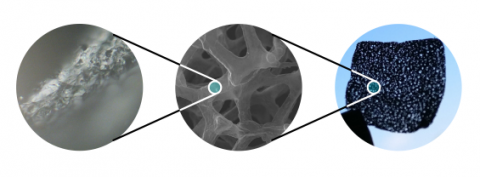Disordered Photonics Behavior from Terahertz to Ultraviolet of a 3-Dimensional Graphene Network

The diffusion of light by random materials is a general phenomenon which appears in many different systems, spanning from colloidal suspension in liquid crystals to metallic networks and papers composed by random fibers. Random scattering is also a key element behind mimicry of several animals, like white beetles and chameleons. Here, scattering is related to micro and nano-size spatial structures affecting a broad range of the electromagnetic spectrum.
The SapienzaTerahertz group at the Physics Department of Sapienza University (Luca Tomarchio, Salvatore Macis and Stefano Lupi), through a collaboration with INFN-LNF (Mariangela Cestelli Guidi e Augusto Marcelli) and the University of Tsukuba in Japan (Yoshikazu Ito) have recently published a paper on NPG Asia Materials, about the light-matter interaction in novel 3D graphene networks. Here, the unique electrical, thermal and optical properties of graphene have been extended into 3D structures by stacking high-quality graphene monolayers in a wide variety of three-dimensional networks. By measuring the optical properties of these 3D networks in a broad spectral range from terahertz to ultraviolet, we demonstrate how 3D graphene behaves like a high-pass optical filter due to its multiscale spatial scatterers.
Thus 3D graphene represents a novel disordered photonic material resembling the complex scattering structures found in biological systems. This similarity opens a pathway to the future exploitation of graphene 3D structures for the fabrication of innovative materials with unique optoelectronic properties.
Authors:
Stefano Lupi
Reference:
NPG Asia Materials
